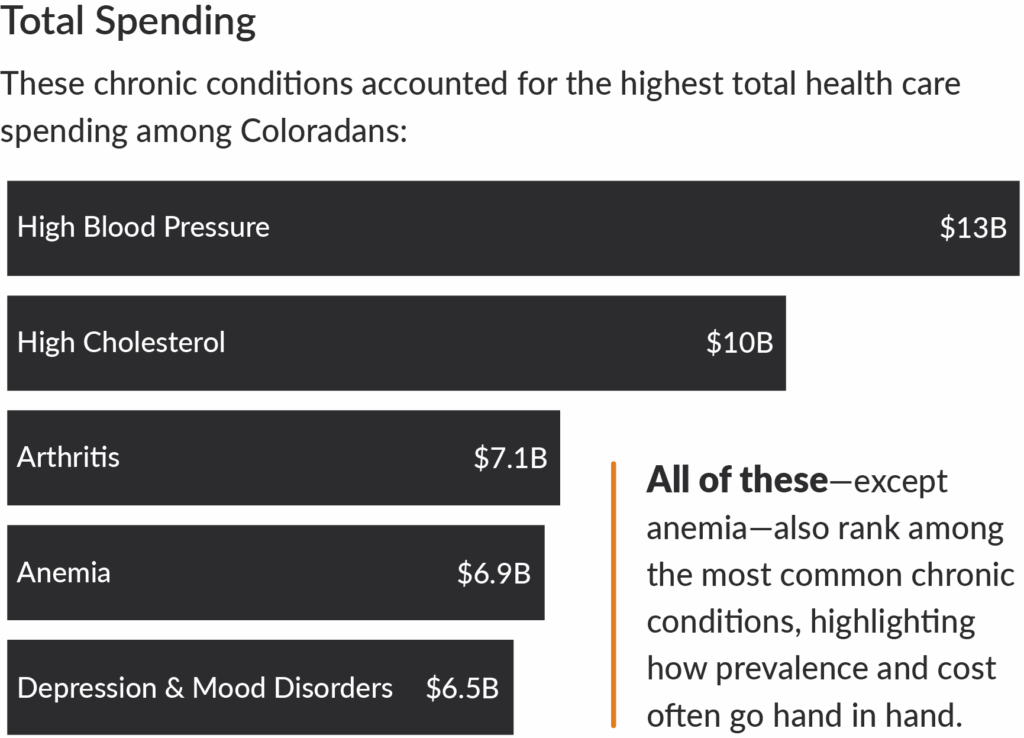A new analysis from the Center for Improving Value in Health Care (CIVHC) shines a spotlight on the impact of chronic conditions in Colorado, uncovering stark insights into both the prevalence and cost of care associated with long-term illnesses. Drawing from the Colorado All Payer Claims Database (CO APCD), this analysis provides a comprehensive look at 30 chronic conditions over a seven-year span from 2017 to 2023.
According to the report, 22% of Coloradans live with at least one chronic condition, and among them, nearly 70% face multiple ongoing health issues. These conditions—ranging from high blood pressure and diabetes to depression and asthma—significantly affect individuals’ quality of life and drive rising health care costs across the state.
This analysis uses the Centers for Medicare & Medicaid Services (CMS) Chronic Conditions Algorithm, which includes conditions such as pneumonia and hip or pelvic fractures. While these are often seen as isolated events, they can become ongoing challenges—particularly for individuals managing multiple chronic conditions. Their inclusion highlights both their high cost and their frequent occurrence among Medicare patients.
“Chronic conditions aren’t just individual health challenges—they’re systemic pressure points. This analysis provides researchers, public health professionals, and policymakers with essential insights into preventable costs and opportunities to enhance care for Coloradans across the state.”
Kristin Paulson, JD, MPH,
This analysis uses the Centers for Medicare & Medicaid Services (CMS) Chronic Conditions Algorithm, which includes conditions such as pneumonia and hip or pelvic fractures. While these are often seen as isolated events, they can become ongoing challenges—particularly for individuals managing multiple chronic conditions. Their inclusion highlights both their high cost and their frequent occurrence among Medicare patients.
Top Conditions by Prevalence and Cost
High blood pressure (11% of eligible population*) and high cholesterol (9% of eligible population*) emerged as the most common chronic conditions in Colorado, followed by arthritis, diabetes, and depression. Notably, mental health and asthma are most prevalent among those under age 35, while heart-related issues become dominant past that age.
Costs tell another compelling story. Conditions like pneumonia and heart attacks carry some of the highest average costs per patient. Pneumonia, in particular, tops the list statewide with an average cost of $83,000 per person per year across all age groups, making it the most expensive condition analyzed in terms of per-person spending.
For patients 65 and older, the having heart attack costs $79,000 per person per year on average. Meanwhile, pneumonia and hip/pelvic fractures, also among the top five most costly conditions, demonstrate how acute events can become long-term cost drivers, particularly for those with other chronic issues.
Important to note, the cost measures described in this analysis reflect the total health care costs a person with a chronic condition had during the year—not just the cost to treat the condition itself. For example, the cost per person per year includes all care they received, not just care for the chronic condition.
Total Statewide Spending
When it comes to total health care spending on chronic conditions in Colorado, high blood pressure and high cholesterol lead the way, accounting for $13 billion and $10 billion per year respectively. Depression, arthritis, and anemia round out the top five most expensive conditions underscoring the dual burden of high prevalence and high cost.
Explore the Data
Chronic conditions often don’t occur in isolation, they’re interconnected and increasingly common among older adults, which is why understanding these data is so critical. To learn more and download the full Chronic Conditions Analysis, visit CIVHC’s website. For more information or additional questions, contact us at info@civhc.org.
* Eligible population is all Colorado residents with insurance coverage through a plan that reports to the CO APCD from 2017 through 2023.

